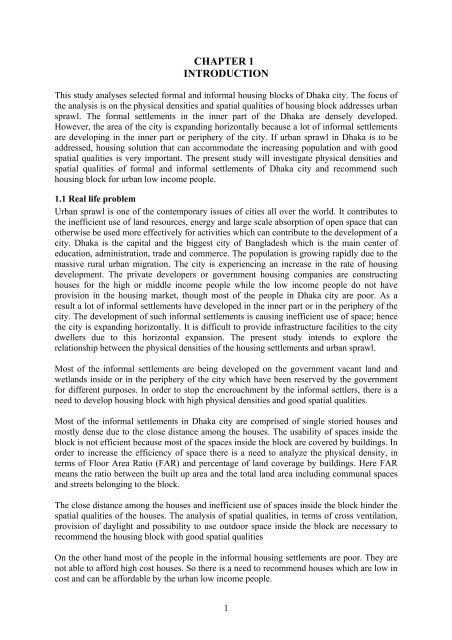Physical Density and Urban Sprawl: A Case of Dhaka City - KTH
Physical Density and Urban Sprawl: A Case of Dhaka City - KTH
Physical Density and Urban Sprawl: A Case of Dhaka City - KTH
You also want an ePaper? Increase the reach of your titles
YUMPU automatically turns print PDFs into web optimized ePapers that Google loves.
CHAPTER 1<br />
INTRODUCTION<br />
This study analyses selected formal <strong>and</strong> informal housing blocks <strong>of</strong> <strong>Dhaka</strong> city. The focus <strong>of</strong><br />
the analysis is on the physical densities <strong>and</strong> spatial qualities <strong>of</strong> housing block addresses urban<br />
sprawl. The formal settlements in the inner part <strong>of</strong> the <strong>Dhaka</strong> are densely developed.<br />
However, the area <strong>of</strong> the city is exp<strong>and</strong>ing horizontally because a lot <strong>of</strong> informal settlements<br />
are developing in the inner part or periphery <strong>of</strong> the city. If urban sprawl in <strong>Dhaka</strong> is to be<br />
addressed, housing solution that can accommodate the increasing population <strong>and</strong> with good<br />
spatial qualities is very important. The present study will investigate physical densities <strong>and</strong><br />
spatial qualities <strong>of</strong> formal <strong>and</strong> informal settlements <strong>of</strong> <strong>Dhaka</strong> city <strong>and</strong> recommend such<br />
housing block for urban low income people.<br />
1.1 Real life problem<br />
<strong>Urban</strong> sprawl is one <strong>of</strong> the contemporary issues <strong>of</strong> cities all over the world. It contributes to<br />
the inefficient use <strong>of</strong> l<strong>and</strong> resources, energy <strong>and</strong> large scale absorption <strong>of</strong> open space that can<br />
otherwise be used more effectively for activities which can contribute to the development <strong>of</strong> a<br />
city. <strong>Dhaka</strong> is the capital <strong>and</strong> the biggest city <strong>of</strong> Bangladesh which is the main center <strong>of</strong><br />
education, administration, trade <strong>and</strong> commerce. The population is growing rapidly due to the<br />
massive rural urban migration. The city is experiencing an increase in the rate <strong>of</strong> housing<br />
development. The private developers or government housing companies are constructing<br />
houses for the high or middle income people while the low income people do not have<br />
provision in the housing market, though most <strong>of</strong> the people in <strong>Dhaka</strong> city are poor. As a<br />
result a lot <strong>of</strong> informal settlements have developed in the inner part or in the periphery <strong>of</strong> the<br />
city. The development <strong>of</strong> such informal settlements is causing inefficient use <strong>of</strong> space; hence<br />
the city is exp<strong>and</strong>ing horizontally. It is difficult to provide infrastructure facilities to the city<br />
dwellers due to this horizontal expansion. The present study intends to explore the<br />
relationship between the physical densities <strong>of</strong> the housing settlements <strong>and</strong> urban sprawl.<br />
Most <strong>of</strong> the informal settlements are being developed on the government vacant l<strong>and</strong> <strong>and</strong><br />
wetl<strong>and</strong>s inside or in the periphery <strong>of</strong> the city which have been reserved by the government<br />
for different purposes. In order to stop the encroachment by the informal settlers, there is a<br />
need to develop housing block with high physical densities <strong>and</strong> good spatial qualities.<br />
Most <strong>of</strong> the informal settlements in <strong>Dhaka</strong> city are comprised <strong>of</strong> single storied houses <strong>and</strong><br />
mostly dense due to the close distance among the houses. The usability <strong>of</strong> spaces inside the<br />
block is not efficient because most <strong>of</strong> the spaces inside the block are covered by buildings. In<br />
order to increase the efficiency <strong>of</strong> space there is a need to analyze the physical density, in<br />
terms <strong>of</strong> Floor Area Ratio (FAR) <strong>and</strong> percentage <strong>of</strong> l<strong>and</strong> coverage by buildings. Here FAR<br />
means the ratio between the built up area <strong>and</strong> the total l<strong>and</strong> area including communal spaces<br />
<strong>and</strong> streets belonging to the block.<br />
The close distance among the houses <strong>and</strong> inefficient use <strong>of</strong> spaces inside the block hinder the<br />
spatial qualities <strong>of</strong> the houses. The analysis <strong>of</strong> spatial qualities, in terms <strong>of</strong> cross ventilation,<br />
provision <strong>of</strong> daylight <strong>and</strong> possibility to use outdoor space inside the block are necessary to<br />
recommend the housing block with good spatial qualities<br />
On the other h<strong>and</strong> most <strong>of</strong> the people in the informal housing settlements are poor. They are<br />
not able to afford high cost houses. So there is a need to recommend houses which are low in<br />
cost <strong>and</strong> can be affordable by the urban low income people.<br />
1

















